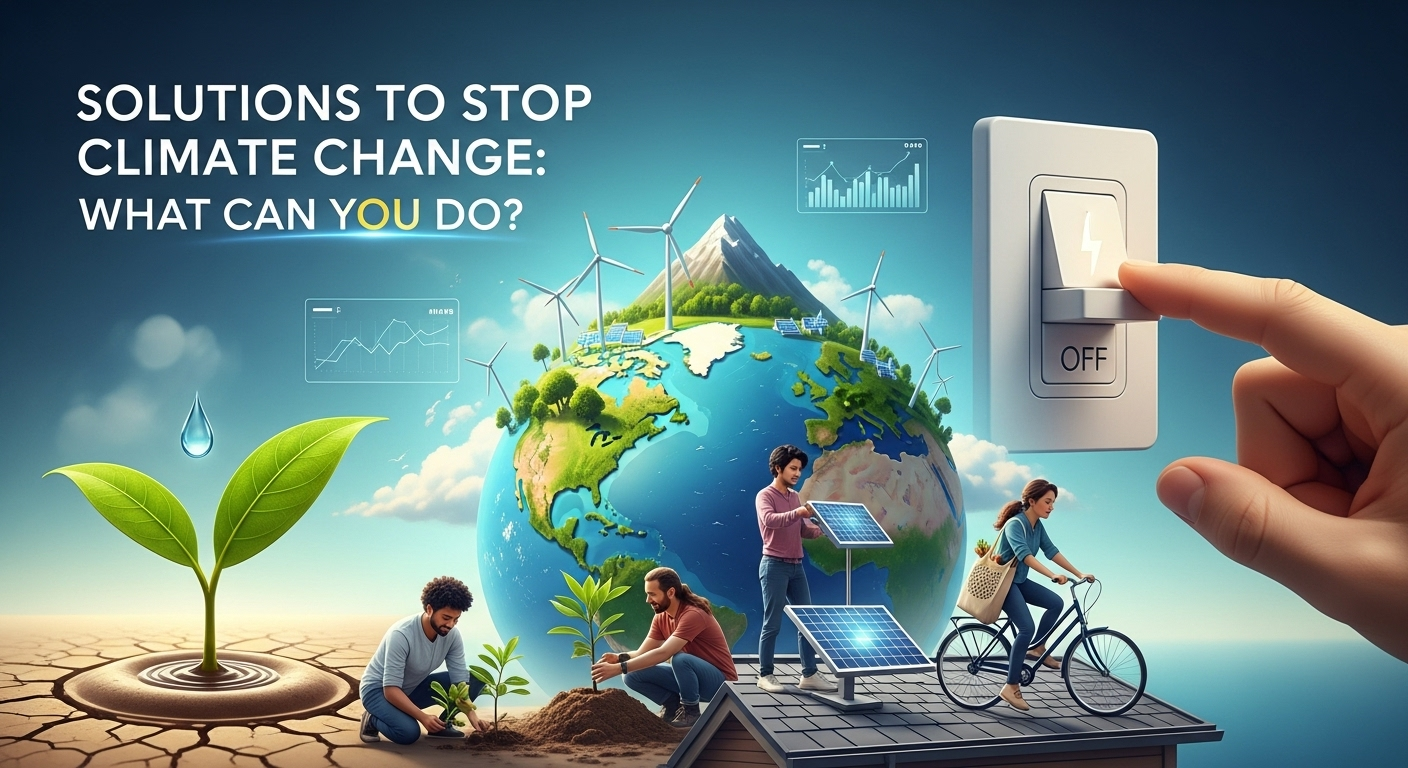The planet is sending out an SOS. From unprecedented heatwaves and devastating floods to melting glaciers and rising sea levels, the evidence of a rapidly changing climate is all around us. For many, the scale of the problem can feel overwhelming, leading to a sense of helplessness. However, despair is not a strategy. The truth is, we have a vast arsenal of effective and accessible solutions to stop climate change at our disposal. This challenge, while monumental, is one we can meet with a combination of technological innovation, policy shifts, and collective individual action. The journey to a sustainable future starts with understanding what can be done and recognizing the powerful role each of us plays in this global effort. The Global Pivot: Transitioning to Clean and Renewable Energy The single largest contributor to global climate change is the burning of fossil fuels—coal, oil, and gas—for energy. These fuels release enormous amounts of carbon dioxide (CO2) and other greenhouse gases into the atmosphere, creating a "blanket" that traps heat and warms the planet. Therefore, the most critical long-term solution lies in a rapid and decisive transition away from these finite, polluting sources and towards clean, renewable energy. This is not a distant futuristic dream; the technology exists, and its adoption is accelerating worldwide. This energy transition represents a fundamental overhaul of our global power infrastructure. It involves decommissioning carbon-intensive power plants and investing heavily in technologies that harness natural forces. The economic argument for this shift is becoming increasingly compelling, as the costs of renewable energy technologies have plummeted over the past decade, making them competitive with—and often cheaper than—fossil fuels in many parts of the world. Governments, corporations, and individuals all have a role to play in accelerating this pivot, through supportive policies, sustainable investments, and personal energy choices. The transition is about more than just swapping out one power source for another; it's about building a more resilient, decentralized, and equitable energy system. Unlike fossil fuels, which are often concentrated in specific geographic regions, renewable resources like sun and wind are available almost everywhere. This decentralization can empower communities, create local jobs, and reduce geopolitical tensions over energy resources. The shift requires significant upfront investment in grids, storage, and technology, but the long-term benefits for a stable climate and a sustainable economy are immeasurable. 1. Harnessing the Sun: The Rise of Solar Power Solar power is a cornerstone of the renewable energy revolution. It works by converting sunlight directly into electricity using photovoltaic (PV) panels or by concentrating solar radiation to heat a liquid and drive a turbine. The beauty of solar lies in its scalability and versatility. It can be deployed on a massive scale in sprawling solar farms that can power entire cities, or on a micro-scale with rooftop panels that allow individual homeowners to generate their own clean electricity. The dramatic drop in the cost of solar panels—over 90% in the last decade—has made it one of the most affordable sources of new electricity generation globally. This has unleashed a an explosion in solar installations, from the deserts of Chile to the rooftops of Germany. For individuals, installing solar panels is a direct way to reduce their carbon footprint, lower electricity bills, and increase energy independence. Even for those who can't install their own panels, many utility companies now offer options to purchase a share of their electricity from renewable sources, making solar power accessible to more people than ever. 2. Capturing the Wind: The Force of Wind Turbines Wind power is another powerhouse in the renewable energy portfolio. Modern wind turbines are engineering marvels, capable of capturing the kinetic energy of the wind and converting it into electricity with remarkable efficiency. Like solar, wind power has seen its costs fall significantly, making it a highly competitive energy source. Wind farms, both onshore and increasingly offshore, are becoming a common sight, providing clean, reliable power to millions. Offshore wind, in particular, holds immense promise. Winds over the ocean are typically stronger and more consistent than on land, allowing for larger and more productive turbines. While the initial investment is higher, offshore wind farms can generate vast amounts of electricity, positioning them as a key solution for coastal population centers. The development of wind energy creates jobs in manufacturing, installation, and maintenance, further contributing to a just transition to a green economy. Rethinking Daily Life: Sustainable Consumption and Lifestyle Choices While large-scale energy transitions are essential, the choices we make every day have a profound and cumulative impact on the climate. Our patterns of consumption—what we buy, what we eat, and how we live—are directly linked to greenhouse gas emissions. Adopting a mindset of sustainable consumption is a powerful solution to stop climate change that empowers every individual to become part of the climate solution. It's about being more mindful of the resources we use and the waste we generate. The familiar mantra of "Reduce, Reuse, Recycle" is more relevant than ever, with a strong emphasis on the first word: Reduce. Recycling is good, but not consuming something in the first place is far better, as it avoids the emissions associated with manufacturing, packaging, and transportation. This means questioning our needs versus our wants, opting for quality over quantity, and resisting the culture of disposability that has become so prevalent. Every decision to repair an item instead of replacing it, or to borrow instead of buying, is a small victory for the planet. Making conscious lifestyle changes is not about deprivation; it's about finding a better, more sustainable way to live. It’s about aligning our actions with our values and recognizing that a healthy planet is the foundation for a healthy life. When millions of people make small, sustainable shifts, the collective result is a massive reduction in global emissions and a powerful market signal to corporations that sustainability is no longer a niche interest but a mainstream demand. 1. The Power of Your Plate: Sustainable Dietary Shifts The global food system is a major





